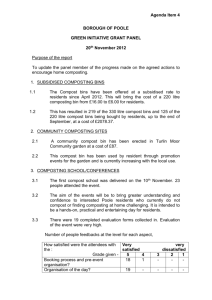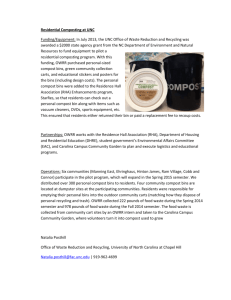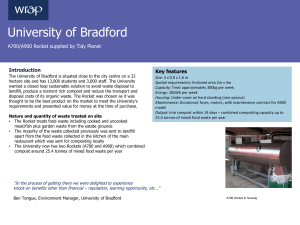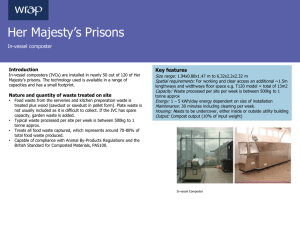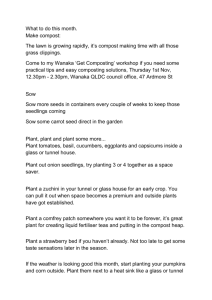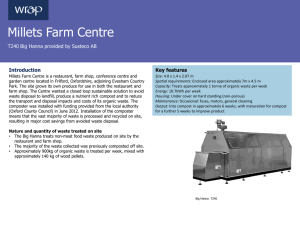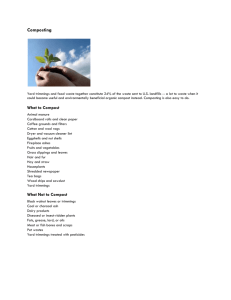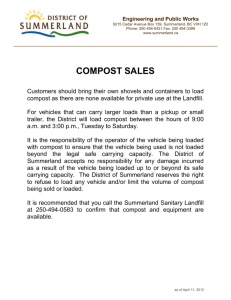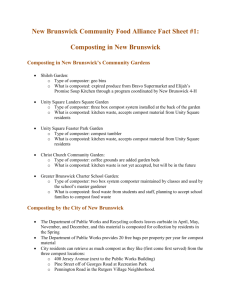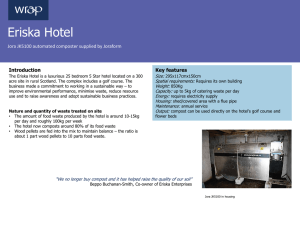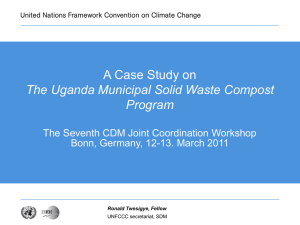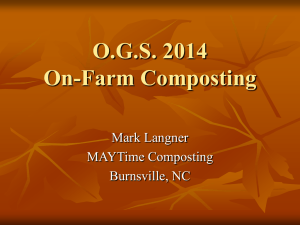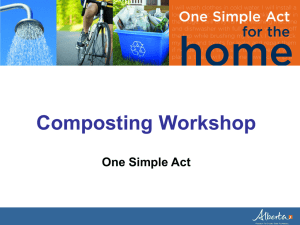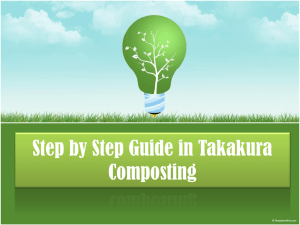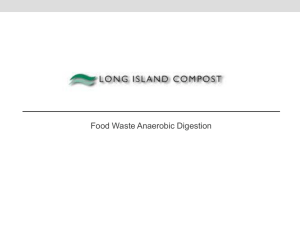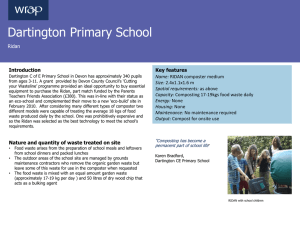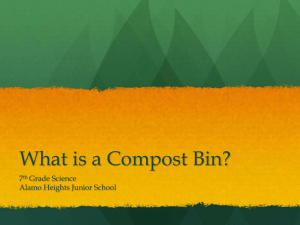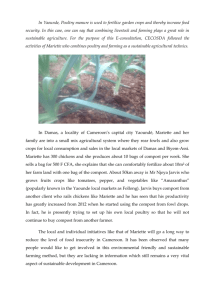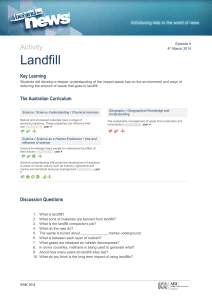Housing 21 case study
advertisement
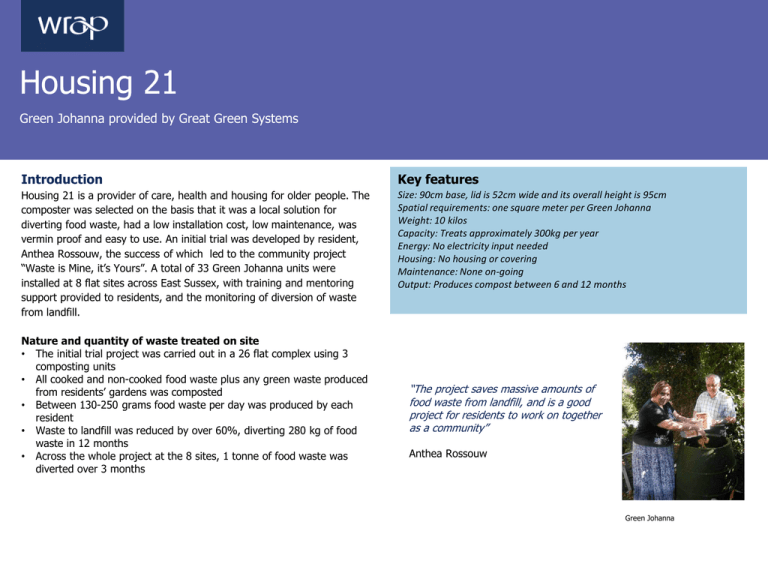
Housing 21 Green Johanna provided by Great Green Systems Introduction Key features Housing 21 is a provider of care, health and housing for older people. The composter was selected on the basis that it was a local solution for diverting food waste, had a low installation cost, low maintenance, was vermin proof and easy to use. An initial trial was developed by resident, Anthea Rossouw, the success of which led to the community project “Waste is Mine, it’s Yours”. A total of 33 Green Johanna units were installed at 8 flat sites across East Sussex, with training and mentoring support provided to residents, and the monitoring of diversion of waste from landfill. Size: 90cm base, lid is 52cm wide and its overall height is 95cm Spatial requirements: one square meter per Green Johanna Weight: 10 kilos Capacity: Treats approximately 300kg per year Energy: No electricity input needed Housing: No housing or covering Maintenance: None on-going Output: Produces compost between 6 and 12 months Nature and quantity of waste treated on site • The initial trial project was carried out in a 26 flat complex using 3 composting units • All cooked and non-cooked food waste plus any green waste produced from residents’ gardens was composted • Between 130-250 grams food waste per day was produced by each resident • Waste to landfill was reduced by over 60%, diverting 280 kg of food waste in 12 months • Across the whole project at the 8 sites, 1 tonne of food waste was diverted over 3 months “The project saves massive amounts of food waste from landfill, and is a good project for residents to work on together as a community” Anthea Rossouw Green Johanna Housing 21 Lessons Learnt The project sought to change behaviour in how residents manage their waste. This is encouraged through green champions at each site, mentoring, newsletters and a contact point if support or assistance in composting is required. How food is separated for treatment • Residents put their food waste into a kitchen caddy and deposit it in the composter each day Use of outputs from treatment The compost produced is used by residents on their gardens, avoiding the purchase of compost How the on-site treatment system is managed • Ideal mix is 1 part garden waste and 2 parts kitchen waste to balance carbon and nitrogen levels • Sometimes necessary to add material such as shredded paper, egg boxes and crushed eggshells to produce a nutrient rich compost if the food waste is too wet • The uppermost layer of the compost is mixed to aerate and to ensure even distribution every time new material is added • Very occasionally, it is necessary to aerate the compost deeper down to ensure all the material is acted upon by the micro-organisms and broken down • For the initial trial at Housing 21, a resident training and skills workshop lasting 2.5 hours was developed and provided by the Project Manager, funded by ESCC, Housing 21 and a gardening company • The training empowered the residents with skills and knowledge on how to compost and what waste types to avoid. Monitoring and support was also provided for the following 3 months. No health and safety difficulties have been reported during the trials • The compost is ready after four to six months • An optional winter jacket can be purchased and used when the ambient temperature falls below 5° C for long periods. Costs • The “Waste is Mine, it’s Yours” project was developed and delivered by Anthea in partnership with the University of Brighton and the housing associations Housing 21 and Amicus Horizon • Financial support was provided by East Sussex County Council (ESCC) and the European Regional Development Fund Interreg IVA (Channel) Programme. The project is now part of the Defra Reward & Recognition Scheme and a report will be published once all projects in the scheme are complete • For the Housing 21 project capital and start-up costs were £105 per composting unit (3 units in total), £4 per kitchen caddy per resident plus training, administration and travel of £15 per flat. Overall, the cost per flat was £22 • Waste disposal costs fell from £36.50 to £23.10 per month • There are no on-going maintenance costs • Can be left in the same place after installation for at least 10 years and can be replaced after that with another one in the same location This case study is part of a series of case studies focussing on the on-site treatment of organic waste. Other case studies in this series are: Eriska Hotel; Dartington Primary school; Millets Farm Centre; University of Southampton; University of Bradford; and Her Majesty’s Prison Service www.wrap.org.uk/on_site_treatment While steps have been taken to ensure its accuracy, WRAP cannot accept responsibility or be held liable to any person for any loss or damage arising out of or in connection with this information being inaccurate, incomplete or misleading. This material is copyrighted. It may be reproduced free of charge subject to the material being accurate and not used in a misleading context. The source of the material must be identified and the copyright status acknowledged. This material must not be used to endorse or used to suggest WRAP’s endorsement of a commercial product or service. For more detail, please refer to our Terms & Conditions on our website - www.wrap.org.uk Waste & Resources The Old Academy Action Programme 21 Horse Fair Banbury, Oxon OX16 OAH Tel: 01295 819 900 Fax: 01295 819 911 E-mail info@wrap.org.uk Helpline freephone 0808 100 2040 www.wrap.org.uk
